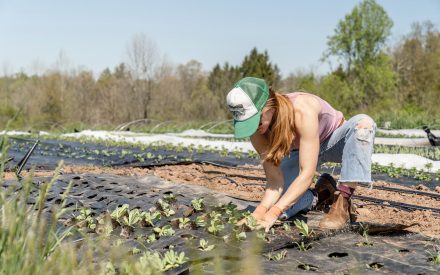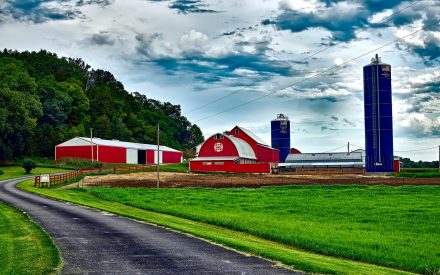In farming, sweat equity is a term that is loosely used to define how established farmers use payment of a commodity or capital assets to replace some of the cash wages for employees. Sweat equity is also the term sometimes used to compensate a successor for years of labor and management that helped build the owner generation’s wealth. It can be used to justify gifting personal, titled property, or giving a discounted price when the property is eventually sold to the successor. When considering labor compensation in forms other than money, the goal of both the employer and employee should be analyzed to ensure it is an appropriate compensation package.
Sweat Equity used for Commodity wages
Forms of commodity payments include:
- Immediately consumable meat, milk, eggs or other food items in place of a cash wage
- A commodity of grain, milk or animals that will be sold and eventually converted to cash
- Breeding stock that can either remain in the employer’s herd or used to start the employee’s own herd
- Transfer of ownership or a percent interest of ownership in a capital farm asset
If the employee’s goal is to learn more about the farm business and gain management skills, commodity payments can provide a way to allow him/her to make management decisions on a smaller scale.
Sweat equity payments in the form of commodities can help the employee gain experience in the management and marketing of the commodity. One example would be the payment of grain allowing the employee to make decisions of when and where to market that grain. Market livestock can provide additional skill development as the employee makes management decisions to raise the livestock to market weight. From the employer’s perspective, skills development can translate into a better employee who can be given more responsibilities. In addition to skill development, the employer may not have the cash flow to completely compensate the employee, but can provide the commodity as part of the wage package. Finally, there can be income tax savings if a portion of the wage is in the form of a commodity. However, if this is the main or only goal, the parties should consider if the tax savings is large enough to warrant the work required to document and adhere to the income tax rules.
If the employee’s goal is to eventually manage their own herd, payments in breeding stock may be a viable option. Again, this provides the opportunity for him/her to develop management skills while the farm manages cash outlays for labor. With this option it is important to consider where the animals will be housed. In the case of a dairy, if animals stays in the original herd, but are owned by the employee how will feed and other ownership costs be paid and how will milk income be distributed? The employer must consider the long-term implications of the employee’s animals remaining in the herd and taking facility space from the owner’s herd. The employer should determine if they can manage the loss of the income? Or does the owner need to calculate overhead costs and charge this expense to the employee?
Sweat Equity used for Succession
When the goal is to slowly transfer business assets to the next generation, sweat equity can provide the transfer of assets or percent interest in assets to the successor. For example, breeding stock can be transferred to the successor over time allowing them to own a significant portion of the herd. This mode of equity transfer can be facilitated by forming a business entity that owns farm assets as shares or interest. These shares or interest can then be transferred to the successor. This option, when clearly outlined in a farm succession plan, can provide the successor generation a guarantee that the assets will be transferred. This guarantee removes the speculation that surrounds a verbal promise of “Someday, this will all be yours”. Sweat equity can also relieve the pressure of cash flow on the operation if the successor can manage their living expenses with a smaller paycheck. One thing to consider with this option is how much of the assets can and should be transferred in this way. Is the owner generation dependent on these assets for retirement? If the answer to this question is yes, how much of the assets can be provided in trade for labor? How much needs to be retained by the owner or be sold to the next generation for cash to fund retirement needs?
Valuing Sweat Equity
Sweat equity is as valuable as cash equity and should have a one-to-one conversion rate. Therefore, it is important to correctly value the items being given as sweat equity. Some commodities have a worldwide market and their value can be more easily determined by this market value. Other commodities produced on farm such as cattle are not as easy to value. While market can be used to determine an animals worth, this may be undervalued if the animal can command a premium above what they could be harvested for. For example, cattle with high value phenotypes or genetics can sell for much higher than market value.
It is important to have production records on these animals including milk, fat and protein to determine the value of these animals. In addition, rolling herd average and classification scores can be useful marketing tools.
In addition, cattle can be appraised to determine their value. This is most commonly done for insurance purposes but also can help determine a baseline value of your herd. To assess the animal’s worth, the appraiser will evaluate the quality of the animal. This can include a comparison of your animals to animals of similar quality that have recently sold. An appraiser may use a calculation to determine fair market value. This calculation will be specific to the type of cattle, cow or replacement.
Milk cow appraisal includes future milk production, future calf production and the current value of the animals in the cull market. Replacement value uses the market value to determine the price of the animal. The majority of markets report values for springing heifers. Calculations based on this value can be used to determine the value of bred heifers, 1-3 months pregnant, and heifers that are 4-6 months pregnant. The price of open animals can also be determined from market value and is broken down by age and weight. Replacements with above average phenotypic or genetic value can also be appraised as a percentage of the milk cow value.
The use of sweat equity allows employees and successors to build equity. It is important to consider if the compensation is equitable for the work done and the tax implications of using sweat equity.

 What are the Tax Implications of Sweat Equity Arrangements on Wisconsin Farms?
What are the Tax Implications of Sweat Equity Arrangements on Wisconsin Farms? Common strategies to consider for Fair vs Equal
Common strategies to consider for Fair vs Equal Farm asset division a 21st-century conundrum
Farm asset division a 21st-century conundrum What is the biggest threat to a farm estate getting to the rightful heirs? It’s probably not what you think
What is the biggest threat to a farm estate getting to the rightful heirs? It’s probably not what you think


